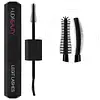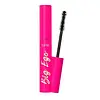Huda Beauty Legit Lashes Double-Ended Volumizing And Lengthening Mascara Versus Tarte Big Ego Mascara
What's inside
What's inside
 Key Ingredients
Key Ingredients

 Benefits
Benefits

 Concerns
Concerns

 Ingredients Side-by-side
Ingredients Side-by-side

Water
Skin ConditioningBeeswax
Emulsion StabilisingStearic Acid
CleansingHelianthus Annuus Seed Wax
Skin ConditioningGlyceryl Behenate
EmollientAcacia Senegal Gum
MaskingPolyglyceryl-6 Distearate
EmulsifyingVp/Eicosene Copolymer
Propanediol
SolventCopernicia Cerifera Wax
Aminomethyl Propanediol
BufferingStearyl Stearate
EmollientGlyceryl Caprylate
EmollientStearyl Palmitate
EmulsifyingHydrogenated Starch Hydrolysate
HumectantMethyl Methacrylate Crosspolymer
Phenoxyethanol
PreservativeHydroxyethylcellulose
Emulsion StabilisingPotassium Sorbate
PreservativeParaffin
PerfumingCetyl Palmitate
EmollientCetyl Stearate
EmollientPolyglyceryl-6 Polyricinoleate
EmulsifyingPanthenol
Skin ConditioningLaureth-20
EmulsifyingMethylpropanediol
SolventPolyethylene Terephthalate
Butylene Glycol
HumectantMagnesium Stearate
Cosmetic ColorantCaprylhydroxamic Acid
Behenic Acid
CleansingMicrocrystalline Wax
Emulsion StabilisingArachidic Acid
Cleansing1,2-Hexanediol
Skin ConditioningPalmitic Acid
EmollientSilica
AbrasiveSodium Phosphate
BufferingDisodium Phosphate
BufferingPolysorbate 20
EmulsifyingCI 77499
Cosmetic ColorantCI 77266
Cosmetic ColorantOryza Sativa Bran Wax
Skin ConditioningNylon-6
Water, Beeswax, Stearic Acid, Helianthus Annuus Seed Wax, Glyceryl Behenate, Acacia Senegal Gum, Polyglyceryl-6 Distearate, Vp/Eicosene Copolymer, Propanediol, Copernicia Cerifera Wax, Aminomethyl Propanediol, Stearyl Stearate, Glyceryl Caprylate, Stearyl Palmitate, Hydrogenated Starch Hydrolysate, Methyl Methacrylate Crosspolymer, Phenoxyethanol, Hydroxyethylcellulose, Potassium Sorbate, Paraffin, Cetyl Palmitate, Cetyl Stearate, Polyglyceryl-6 Polyricinoleate, Panthenol, Laureth-20, Methylpropanediol, Polyethylene Terephthalate, Butylene Glycol, Magnesium Stearate, Caprylhydroxamic Acid, Behenic Acid, Microcrystalline Wax, Arachidic Acid, 1,2-Hexanediol, Palmitic Acid, Silica, Sodium Phosphate, Disodium Phosphate, Polysorbate 20, CI 77499, CI 77266, Oryza Sativa Bran Wax, Nylon-6
Water
Skin ConditioningStearic Acid
CleansingSynthetic Beeswax
Emulsion StabilisingHelianthus Annuus Seed Wax
Skin ConditioningGlyceryl Behenate
EmollientParaffin
PerfumingPolyglyceryl-6 Distearate
EmulsifyingAcacia Senegal Gum
MaskingVp/Eicosene Copolymer
Propanediol
SolventAminomethyl Propanediol
BufferingHydrogenated Starch Hydrolysate
HumectantPhenoxyethanol
PreservativeHydroxyethylcellulose
Emulsion StabilisingPotassium Sorbate
PreservativePanthenol
Skin ConditioningLauroyl Lysine
Skin ConditioningSilica
AbrasiveLaureth-20
EmulsifyingMagnesium Stearate
Cosmetic ColorantButylene Glycol
HumectantOrbignya Oleifera Seed Oil
Emollient1,2-Hexanediol
Skin ConditioningGlycerin
HumectantDisodium Phosphate
BufferingPolysorbate 20
EmulsifyingSodium Phosphate
BufferingTocopherol
AntioxidantBiotinoyl Tripeptide-1
CI 77499
Cosmetic ColorantCI 77266
Cosmetic ColorantWater, Stearic Acid, Synthetic Beeswax, Helianthus Annuus Seed Wax, Glyceryl Behenate, Paraffin, Polyglyceryl-6 Distearate, Acacia Senegal Gum, Vp/Eicosene Copolymer, Propanediol, Aminomethyl Propanediol, Hydrogenated Starch Hydrolysate, Phenoxyethanol, Hydroxyethylcellulose, Potassium Sorbate, Panthenol, Lauroyl Lysine, Silica, Laureth-20, Magnesium Stearate, Butylene Glycol, Orbignya Oleifera Seed Oil, 1,2-Hexanediol, Glycerin, Disodium Phosphate, Polysorbate 20, Sodium Phosphate, Tocopherol, Biotinoyl Tripeptide-1, CI 77499, CI 77266
Ingredients Explained
These ingredients are found in both products.
Ingredients higher up in an ingredient list are typically present in a larger amount.
1,2-Hexanediol is a synthetic liquid and another multi-functional powerhouse.
It is a:
- Humectant, drawing moisture into the skin
- Emollient, helping to soften skin
- Solvent, dispersing and stabilizing formulas
- Preservative booster, enhancing the antimicrobial activity of other preservatives
Acacia Senegal Gum has skin soothing, thickening, and formulation stabilizing properties. It comes from the Acacia tree that is native to sub-Saharan Africa.
We don't have a description for Aminomethyl Propanediol yet.
Butylene Glycol (or BG) is used within cosmetic products for a few different reasons:
Overall, Butylene Glycol is a safe and well-rounded ingredient that works well with other ingredients.
Though this ingredient works well with most skin types, some people with sensitive skin may experience a reaction such as allergic rashes, closed comedones, or itchiness.
Learn more about Butylene GlycolCi 77499 is also hydrated iron III oxide. It is created from mixing red and black iron oxides. This helps give shades of darkness to a product.
Iron III oxides are classified as inorganic chemicals for coloring.
Disodium Phosphate is a water-soluble powder used as a pH adjuster.
Glyceryl Behenate is a fatty acid created from glycerin and behenic acid. It is an emollient and emulsifier.
This ingredient may not be Malassezia folliculitis, or fungal acne safe.
Helianthus Annuus Seed Wax is created from the common sunflower.
Sunflower seed wax is made up of long chain non-glyceride esters, a small amount of fatty alcohols, and fatty acids.
This ingredient is often used to enhance the texture of products. The fatty acid properties also help hydrate the skin.
Learn more about Helianthus Annuus Seed WaxWe don't have a description for Hydrogenated Starch Hydrolysate yet.
Hydroxyethylcellulose is used to improve the texture of products. It is created from a chemical reaction involving ethylene oxide and alkali-cellulose. Cellulose is a sugar found in plant cell walls and help give plants structure.
This ingredient helps stabilize products by preventing ingredients from separating. It can also help thicken the texture of a product.
This ingredient can also be found in pill medicines to help our bodies digest other ingredients.
Learn more about HydroxyethylcelluloseWe don't have a description for Laureth-20 yet.
Magnesium Stearate is a salt that is 2 parts stearic acid and 1 part magnesium.
It is a white powder that can be used to add bulk and color to products by binding to oil ingredients.
Panthenol is a common ingredient that helps hydrate and soothe the skin. It is found naturally in our skin and hair.
There are two forms of panthenol: D and L.
D-panthenol is also known as dexpanthenol. Most cosmetics use dexpanthenol or a mixture of D and L-panthenol.
Panthenol is famous due to its ability to go deeper into the skin's layers. Using this ingredient has numerous pros (and no cons):
Like hyaluronic acid, panthenol is a humectant. Humectants are able to bind and hold large amounts of water to keep skin hydrated.
This ingredient works well for wound healing. It works by increasing tissue in the wound and helps close open wounds.
Once oxidized, panthenol converts to pantothenic acid. Panthothenic acid is found in all living cells.
This ingredient is also referred to as pro-vitamin B5.
Learn more about PanthenolParaffin is a solid created from petroleum. The term 'paraffin' can also refer to either
petroleum jelly or mineral oil.
It has natural occlusive properties which can worsen oily skin. Due to its petrolatum base, this ingredient is not fungal-acne safe.
Phenoxyethanol is a preservative that has germicide, antimicrobial, and aromatic properties. Studies show that phenoxyethanol can prevent microbial growth. By itself, it has a scent that is similar to that of a rose.
It's often used in formulations along with Caprylyl Glycol to preserve the shelf life of products.
Polyglyceryl-6 Distearate isn't fungal acne safe.
Polysorbate 20 is made by combining ethoxylation of sorbitan, ethylene oxide, and lauric acid. It is a mild cleansing agent, surfactant, and emulsifier.
As a surfactant, it helps collect dirt and oils for washing. Emulsifiers prevent oils and water from separating.
Polysorbate 20 also adds scent to a product. Since it is made using sorbitol, it has a sweet scent. Sorbitol can also be found in fruits such as apples and peaches.
The lauric acid used to create Polysorbate 20 is often derived from coconuts.
Polysorbate 20 may not be fungal acne safe.
Learn more about Polysorbate 20Potassium Sorbate is a preservative used to prevent yeast and mold in products. It is commonly found in both cosmetic and food products.
This ingredient comes from potassium salt derived from sorbic acid. Sorbic acid is a natural antibiotic and effective against fungus.
Both potassium sorbate and sorbic acid can be found in baked goods, cheeses, dried meats, dried fruit, ice cream, pickles, wine, yogurt, and more.
You'll often find this ingredient used with other preservatives.
Learn more about Potassium SorbatePropanediol is an all-star ingredient. It softens, hydrates, and smooths the skin.
It’s often used to:
Propanediol is not likely to cause sensitivity and considered safe to use. It is derived from corn or petroleum with a clear color and no scent.
Learn more about PropanediolSilica, also known as silicon dioxide, is a naturally occurring mineral. It is used as a fine, spherical, and porous powder in cosmetics.
Though it has exfoliant properties, the function of silica varies depending on the product.
The unique structure of silica enhances the spreadability and adds smoothness, making it a great texture enhancer.
It is also used as an active carrier, emulsifier, and mattifier due to its ability to absorb excess oil.
In some products, tiny microneedles called spicules are made from silica or hydrolyzed sponge. When you rub them in, they lightly polish away dead skin layers and enhance the penetration of active ingredients.
Learn more about SilicaSodium phosphate is a group of inorganic sodium salts (mono, di, and tri-sodium phosphate). It has pH buffering, chelating, and stabilizing properties.
This means it helps maintain a formula's acidity, enhances preservative performance, and prevents unwanted changes caused by metal ions or hard water.
Sodium phosphate is considered safe for use in cosmetics according to the Cosmetic Ingredient Review (CIR); it also has a long-established food-grade safety rating as well.
Though some sources claim sodium phosphate can help "energize skin cells", this claim is not strongly supported by independent scientific studies.
Learn more about Sodium PhosphateStearic Acid is a fatty acid. It is an emollient, emulsifier, and texture enhancer.
As an emollient, stearic acid helps soften skin. It aids the skin's protective barrier by preventing water loss. It also provides a gentle cleansing effect without stripping away natural oils.
Stearic acid may also be used to enhance the texture of products. It can add volume and stabilize ingredients such as water and oil. This can help water and oil ingredients from separating.
Sources of stearic acid include animal or vegetable fats/oils such as coconut or shea. It can be naturally found in butter, cocoa butter, shea butter, vegetable fats, and animal tallow.
This ingredient may not be Malassezia folliculitis, or fungal-acne safe.
Learn more about Stearic AcidWe don't have a description for Vp/Eicosene Copolymer yet.
Water. It's the most common cosmetic ingredient of all. You'll usually see it at the top of ingredient lists, meaning that it makes up the largest part of the product.
So why is it so popular? Water most often acts as a solvent - this means that it helps dissolve other ingredients into the formulation.
You'll also recognize water as that liquid we all need to stay alive. If you see this, drink a glass of water. Stay hydrated!
Learn more about WaterCI 77266 is a high-purity pigment used to create an intense black color in cosmetics. It is made up of fine particles of pure carbon. This ingredient is also often listed as Carbon Black in ingredient lists.
You'll likely find this ingredient in mascaras, eyeliners, brow products, and eye shadow.
In the US, this ingredient can only be used if it meets strict FDA specifications. Certain versions even require batch-by-batch certification after extensive safety evaluation.
In the European Union, this ingredient is permitted as a colorant and classified as a "nanomaterial" based on its particle size (meaning it requires deeper assessment).
The EU Scientific Committee on Consumer Safety (SCCS) has reviewed nano-sized carbon black specifically and concluded that it does not pose a risk to human health when used in cosmetic products applied to healthy, intact skin and formulated to avoid inhalation.
Studies support this regulatory stance. Laboratory studies on nano-carbon black show potential for cytotoxicity and inflammatory effects in immune cells; it is important to highlight these findings are based on in vitro (not done on a living organism) testing or inhalation scenarios rather than normal topical cosmetic use.
Occupational studies involving industrial workers exposed to airborne carbon black have not shown a clear link between cumulative exposure and cancer risk. These findings are not directly applicable to cosmetics; cosmetic formulations bind pigments within creams, gels, and liquids that are not inhaled.
Overall, evidence shows that this ingredient is safe under regulatory guidelines and purity standards, especially when formulated to avoid airborne exposure.
Even with regulatory approval and a long history of use, some consumers might prefer to avoid ingredients that are petroleum-derived or that fall under the “nanomaterial” category.
Choosing whether to use CI 77266 isn’t necessarily about safety alone; it can also be about personal philosophy, comfort level with synthetic versus natural ingredients, and how much weight you place on ongoing research and regulatory oversight.
Makeup is highly individual, and personal preference plays an important role in deciding what feels right for you.
Learn more about CI 77266